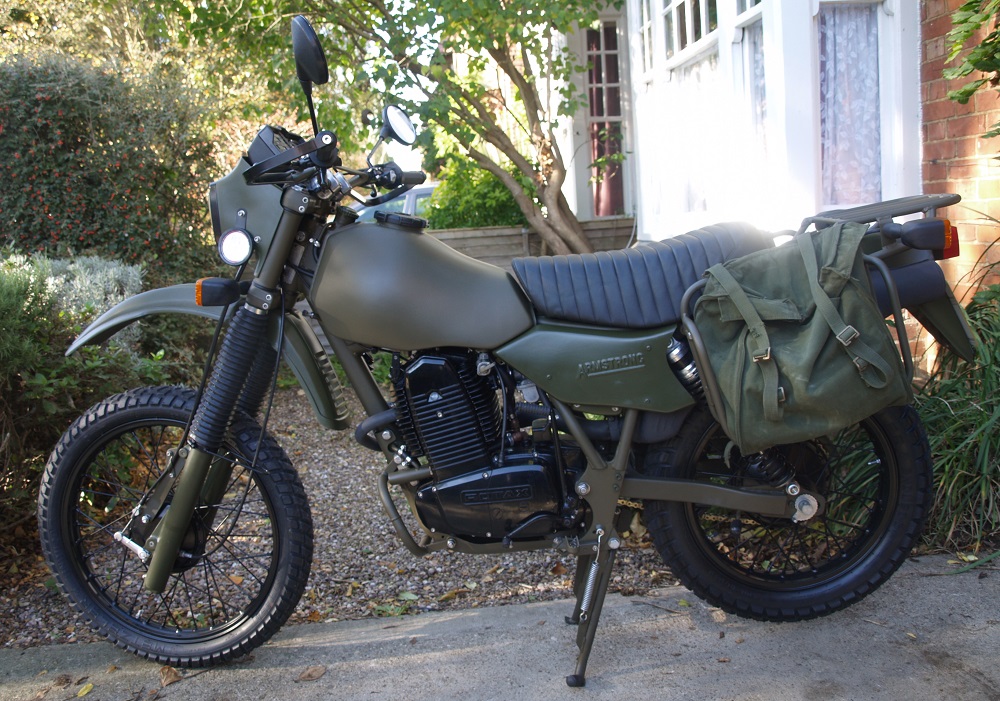Armstrong motorcycles were built in Bolton between 1984-1987 at what was formerly the off-road motorcycle specialist firm Clews Competition Motorcycles (CCM) founded by Alan Clews. Alan Clews made his name as a trials and scrambler rider in the 1960’s and set up CCM in 1971. With the closure of the BSA Competition Department, he bought up all the remaining work’s parts and then started to develop his own lighter BSA B50 engined off-road competition bikes. In the mid-1970’s, CCM then achieved respectable results in the 500 cc motocross world championships.
In 1981 the firm of Armstrong, who were well established in the automotive equipment industry, bought a controlling stake in CCM in order to become involved in making motorcycles for the military market. In 1983 they licensed the rights to build the Can-Am motorcycle in the UK from the Canadian Bombardier company which they then produced until 1987. The British Army bought limited numbers of the Can-Am Bombardier in order to replace the ageing BSA B40WD that was introduced in 1967.
In 1984 Armstrong-CCM then bought the rights to the Rotax engined XN Tornado from the Milan based SWM company after they had gone into liquidation. From this they developed the Armstrong MT500 and then produced about 3,500 of the bikes for the British Army between 1984 and 1987. They also produced a limited number of MT500’s for the Canadian and Jordanian armies. However, in 1987, after the MT500 had been adopted as the standard motorcycle for NATO, Armstrong sold the rights to Harley Davidson who took over production in the United States where they produced the Harley Davidson badged MT350 version of the motorcycle. The British Army began buying this version in 1993.
The Armstrong MT500 and Harley Davidson MT350 are well engineered motorcycles with robust frames and engines that can take a reasonable amount of abuse. Although relatively heavy at 162 kg dry weight for off road use, they are ideal for green laning with a reasonable suspension system and good ground clearance. With the appropriate gearbox sprocket fitted (19T), the MT500 has good performance for normal road use and will cruise all day at 70 mph. In contrast, the MT350 is a little underpowered for road use in comparison and needs to be worked hard to achieve similar levels of performance and has a reduced maximum cruising speed.
Buying Guide
A few years ago, the army was still in the process of disposing of batches of old MT350’s at knock down prices but this source has now completely dried up. At least one dealer still holds a relatively large stock of these bikes but, for most people, acquiring an MT350 or MT500 will be via a private sale. Expect to pay up to about £1200 for a MT500 in good condition but up to double this for an equivalent MT350. That said, a couple of MT350’s recently sold online for less than £1200 and so bargains can be obtained if you are prepared to be patient.
I presently own an Armstrong MT500, an Armstrong MT560E and a Harley Davidson MT350E. The MT500 and MT350E were in a usable on the road state when I bought them but the MT560E had not been run for about 12 years and was in very poor condition. As was the case with mine, most MT’s will be relatively low mileage because the army tended not to use them that extensively. So, finding an MT with less than 20,000 km (12,000 miles) on the clock is not that difficult and many MT350’s can be found having done less than 10,000 km.
Buying a 20+ year old bike is like buying any other vehicle of that age; it’s unlikely in most cases to have a decent service history and it will be very difficult to determine how well it has been treated during its long lifetime, especially the time when it was used by the army. Unless the MT has had a more recent restoration, you can only really judge the condition of most MT’s by how it now looks and rides. If it looks rough externally, there’s a good chance that it is rough internally, whereas, if the outside is tidy, it stands a better chance of having been properly looked after in more recent times.
The first thing to check is its external condition. As with any motorbike, its best to look for obvious signs of crash damage to the petrol tank, handlebar levers and controls, indicator stalks as well as damage to the frame and fittings. This type of check is particularly important for an MT because it was probably used off road at some point, at the very minimum, during its army days. The MT frame is strong but can be damaged and bent in a crash.
The Rotax engine will normally continue running ok even with some worn out components and bearings – my Rotax 560E was a good example of this following a botched professional rebuild! When running, the Rotax engine should not make any unusual mechanical sounds including whirring sounds or any knocking or clattering. The exception is the clutch which can squeal a little in normal use. If the engine does make unusual noises then it probably will need some internal attention. Unfortunately, even if it appears to run well, that is not a complete guarantee that it is in good condition unless the seller can provide some evidence that it has been overhauled or well looked after over an extended period.
While the engine is running, it is well to check the condition of the exhaust system at the same time. If it’s fitted with stainless steel sections then these will last forever but steel parts will rust over time, especially if its still got the original silencer fitted. The silencer should be checked for blowing especially from the lower end which tends to rust first. Also check for blowing under the mounting brackets because mud tends to collect there and cause rusting.
Unfortunately, to be absolutely sure of the condition of an MT, you have to take it apart to examine the condition of the bearings and seals, whether in the wheels, steering head, swinging arm or the engine which is a lot of work. The alternative is simply to run it until the wear becomes so bad and the handling or noise become too painful to continue in this way any longer!
18,103 total views, 12 views today


